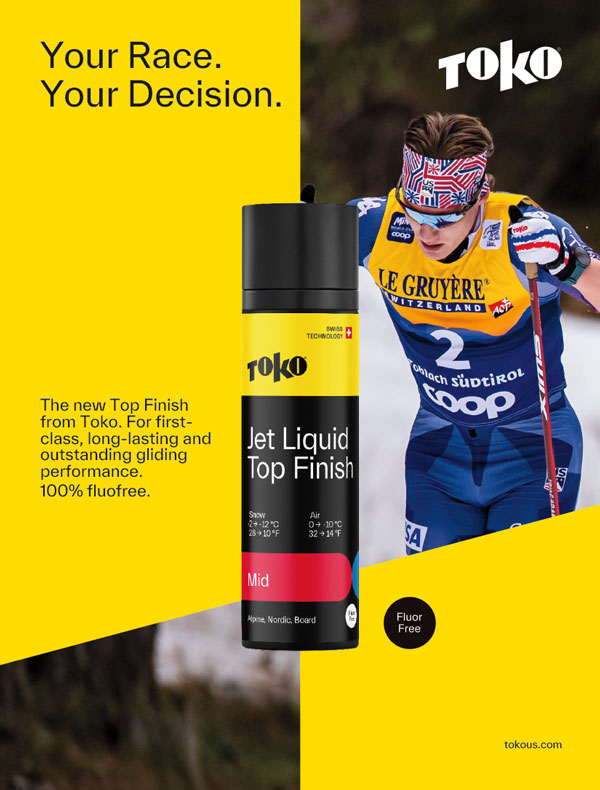
Thoughts on World Cup waxing and bad skis
Kris Freeman
Wed, Dec 12, 2007 - By Zach Caldwell
Some of the questions posed over the past couple of days in the comments to the past couple of posts need to be addressed. I can’t comment on the specifics of the Davos races because I wasn’t there. I don’t know what waxes were in play, what combinations were tried, why hairies weren’t part of the equation, etc. What I do know is that the USST service staff is made up of three experienced professionals who take a great deal of pride in their work, and have had a great deal of success. There is nobody working domestically who is qualified to question their methods and procedures without a whole lot of specific knowledge. I include myself in that generalization.
World Cup waxing is a different thing altogether than taking care of your own skis. It’s important to note that World Cup fields are incredibly tight, and you can’t possibly comprehend the difference that bad (or good) skis might make on the world cup when you’re looking at and thinking in terms of domestic competition. To put it in perspective, Kris was the second North American on Saturday. He got beat by Devon Kershaw. If that race had been run in North America it wouldn’t have looked like the disaster that it was. He would have dropped from first to second (compared with the week before) instead of 5th to 50th. If Kris goes to US Nationals and wins a distance race by a minute, does that mean he has good skis or bad skis? Does it matter? He’s skiing at a level where there aren’t a lot of people poised to step in and take advantage of a mistake. Most masters racers might ride a great wax job a few places up the results list from their usual spot, or they might get beat by a few guys they usually beat when they’ve got bad skis. The racing over here is just not that tight, and this means that “good skis” can be “good enough” skis.
For a racer who is waxing his own skis and racing against domestic competition the best service scenario is to have a few pairs of skis that are totally known quantities. When you’re not going for the last few percent on the wax job you can afford to play it safe and not screw up. The same is true of waxes. For a self-supported racer on the domestic scene the best strategy by far is to learn a wax line and use it intelligently. You don’t need to have the best wax in the world, you need to be in the race. But “in the race” in domestic competition can be twenty places out on the World Cup.
Trust me, if the best approach to World Cup service was for each athlete to carry a few pairs of skis and be personally accountable for getting the wax right, that would be the model. But that model is simply not competitive at that level. It’s necessary to go for the sharp point of the pyramid – especially on days when skis make a big difference.
Going for a higher level of refinement means carrying more skis in more constructions and flexes. It means testing more waxes. It means judgement calls that most of the readers of this site are totally unfamiliar with. It means managing more variables than you’re aware of. Each waxer has his own ways of quantifying and managing those variables. When the going gets tough it’s important to have a handle on all those variables.
Davos was the first time that the new USST service staff had seen many of Kris’s klister skis. They were trying to integrate old skis – the skis that Kris knows and trusts, with newly selected and ground skis. But they’ve all got different flex markings and grinds, etc. In a perfect world the European based service staff would have had access to all the skis well in advance, and would have had plenty of opportunity to test them on snow. That’s why Larry is taking most of Kris’s fleet home from Davos to spend some time putting all the variables into his terms.
Kris will fly back after Rybinsk for a period of training and domestic competition. He’s coming back with five pairs of skis that he knows well. For US Nationals, that’s all he’ll need. US Nationals is not the World Cup. The best strategy at US Nationals is going to be to not screw up. On a great day he could potentially win a 15 distance race at Nationals by three minutes. On a lesser day he could win it by a minute. Nobody really cares whether it’s three minutes or a minute aside from the guys trying to get points behind him.
After Nationals Kris will go straight to Canmore to prepare for the World Cups later in January. Larry will bring the rest of his skis over on the 16th. I’ve just been in Canmore scouting conditions and courses. I’ll talk with Larry in the next few days and tell him what I know.
Rule number one of ski waxing is don’t screw up. Nobody is immune to getting it wrong – sometimes disastrously wrong – from time to time. When conditions are changing quickly and you’ve got to make a decision without the benefit of testing, you’re rolling the dice. In Davos Kris had bad skis – probably some of the worst skis in the race. Kris is not one to pull punches, but he’s smart enough to know when a bad decision is just a bad decision, and a not a break-down of the system. The rest of us would do well to keep this in mind.
Reprinted with permission from the Kris Freeman website at http://www.krisfreeman.net/. Copyright © Zach Caldwell and Kris Freeman

